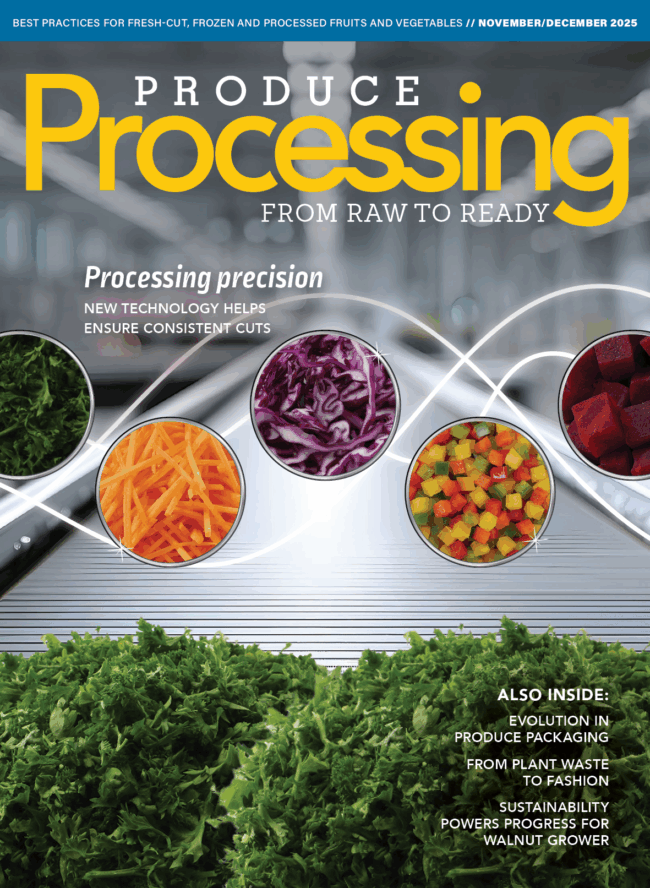Food Innovation and Differentiation
The fresh-cut produce marketplace offers tremendous opportunities, and continues to grow and evolve each year as a result of increasing consumer demand.
Products can be sold to a wide array of potential customers, and in a great variety of forms and formats. They can command premium pricing and positioning if marketed as a value-added “specialty food,” which is among the fastest growing segments of the food industry. According to the Specialty Food Association, U.S. sales of specialty foods skyrocketed by over 22 percent between 2010 and 2012, and dollar volume for the industry grew an impressive 14.3 percent in 2013.
As fresh-cut produce processors consider new business opportunities, it is critical to think strategically about how resultant products can truly be differentiated. A “unique selling position” is the factor or consideration presented by a seller as the reason that your product (and/or your service) is different from and better than that of the competition. Some questions to ask are:
- What is your product concept?
- Who is your target customer?
- How will you market to your target customer?
- Who is your competition?
- What is your point of difference from your competition?
- Does your product address an unmet consumer need?
- How is your product unique, and what are its benefits?
Changes in consumer demands, along with needed enhancements to food safety and quality, are driving tremendous innovation in the retail and foodservice marketplace. Consumers today are seeking foods that are convenient, nutritious, easy to prepare, fresh, flavorful, visually appealing, portion controlled and, above all, that taste great.
It is said that “perception” drives trial in the food marketplace, in which the objective is to communicate the brand, imagery, freshness, wholesomeness, nutritional content, and sensory stimuli that results in trust, and affects the initial purchase of a food product. However, it is also said that it is “reality” that affects the repeat purchase, in which the overall experience and value provided by the food product will demonstrate whether this promise has been fulfilled. Surveys have continually shown that taste is the most powerful criterion for repeat purchase.
Food technologies are critical in providing the product attributes that enable this initial and repeat product purchase. In addition, food technologies are critical to enhancing product safety and extending product shelf life. A number of food technologies have been developed that are aimed at preventing food pathogens from contaminating and/or growing on food products. These technologies are identified as “hurdles” or “barriers” and have varying effects on the safety and shelf life of food products. Their level of effectiveness is dependent in part on which technology is used, the degree to which these technologies are applied, and whether multiple hurdle and barrier technologies are used.
Just as their name implies, “hurdle” technologies can in fact be “overcome” by food pathogens. Nevertheless, deployment of these technologies can make foods increasingly impenetrable by pathogens. While a bacterial pathogen may overcome a single hurdle, or maybe even two hurdles, the use of multiple hurdles in a food product greatly reduces the probability that a pathogen will overcome them all.
Hurdle technologies used in the manufacturing of value-added fresh-cut produce products are tools in the toolbox that can be employed, and include:
- Good agricultural practices — including GAP certification, rapid cooling and sanitary on-farm harvesting and post-production processes
- Formulation technologies — including utilization of abrasive scrubbing and antimicrobial systems used in vegetable/fruit washing, bactericidal agents used in product sauces or marinades, pH control, water activity control, etc.
- Packaging technologies — that include film materials that affect oxygen transmission rate, light transmission, condensation and product respiration; modified atmosphere packaging which alters the gas environment within a package; and active and intelligent packaging systems that provide an array of benefits such as the scavenging of oxygen or release of carbon dioxide, or indicators that mimic temperature abuse or the ripening of produce.
- Thermal or non-thermal processing hurdles — which may include the heating of product either before or after the packaging process, and include techniques such as hot-fill processing and sous vide post-packaging pasteurization; or non-thermal “cold pasteurization” techniques such as ultra high pressure processing
- Distribution systems — that can maintain “superchill” temperatures, just a few degrees above the freezing point of the product and on a consistent basis throughout as much as the life cycle of the product as possible.
New product success requires innovation and differentiation, and the application of a broad array of scientific disciplines. Food business owners, operators, marketers and technologists must assess the physical, chemical and biological characteristics of their fresh-cut food products through all phases of its manufacture and processing and from farm to fork, which starts with the raw material and ends with its final presentation to the consumer. The application of food technologies, integrated with culinary expertise, is critical for success in the retail and foodservice marketplace.
Lou Cooperhouse is president and CEO of Food Spectrum and Food Innovation Holdings, and is focused on global best practices in food innovation, business incubation, and entrepreneurship development.
For further information, contact lcooperhouse@foodspectrum.com










